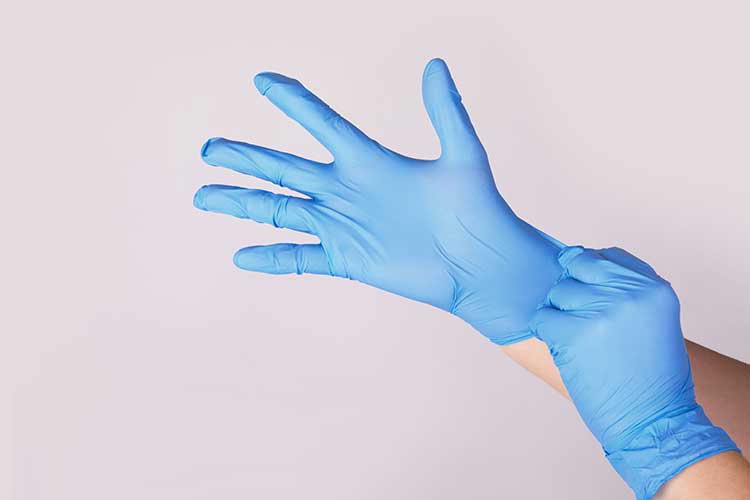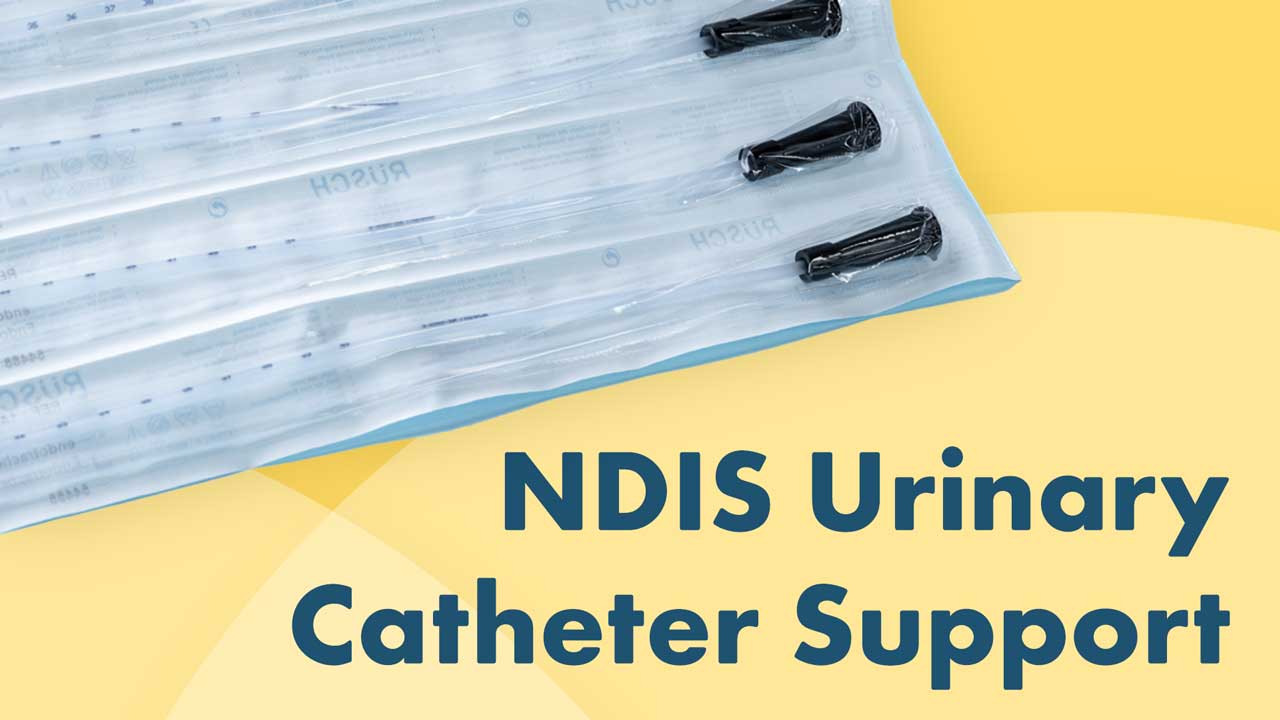Note: This article is intended for NDIS workers and providers. For an explanation of the catheterisation procedure (intended for health practitioners), see Caring For a Urinary Catheter.
Workers employed by National Disability Insurance Scheme (NDIS) providers, who deliver supports to NDIS participants requiring urinary catheter management, must be able to provide appropriate care.
This article will outline the urinary catheter support responsibilities of workers under the NDIS.
What is a Urinary Catheter?
A urinary catheter is a hollow, flexible tube inserted into the bladder that drains urine into an external collection bag (Weatherspoon & Cafasso 2023).
Generally, urinary catheters are used by patients who are unable to urinate on their own or have impaired mobility. They are essential in avoiding a build-up of urine, which has the potential to cause pressure in the kidneys and lead to kidney failure (Weatherspoon & Cafasso 2023).
Types of Catheters

NDIS support workers might assist in the care of three different types of catheters: indwelling, suprapubic and in-out (intermittent).
- Indwelling catheters are inserted through the urethra and remain inside the bladder for a prolonged period of time. Once the catheter has been inserted, a water-filled balloon keeps it in place.
- Suprapubic catheters are a type of indwelling catheter that is inserted through the wall of the abdomen, a few inches below the navel and above the pubic bone, into the bladder.
- In-out catheters are inserted through the urethra to drain the bladder and then removed once the bladder has been drained. Each time drainage is required, a new catheter is inserted and then taken out.
(NHS 2023; Better Health Channel 2021)
Note: Indwelling and suprapubic catheters must only be inserted by an appropriately trained health practitioner. Support workers can insert intermittent catheters, but only under the oversight of a health practitioner (NDIS 2022).
Urinary Catheter Management in the NDIS Practice Standards
Urinary catheter management is a requirement of the NDIS Practice Standards under the High Intensity Daily Personal Activities Module.
This Practice Standard aims to ensure that NDIS participants who require a catheter receive appropriate catheter management that is relevant and proportionate to their individual needs (NDIS 2021).
Under these standards, NDIS providers must meet the following quality indicators:
- Participants are enabled to engage in the assessment and development of a catheter plan. This plan identifies possible risks, incidents and emergencies, and what actions need to be taken to manage these situations, including an escalation of care, if necessary. The participant’s health status is reviewed regularly (with their consent).
- Workers who provide catheter management are informed by appropriate policies, procedures and training plans. These relate to the supports being provided to each participant.
- Workers who provide catheter management have received all necessary training that relates to each specific participant, either from a qualified health practitioner or another appropriately qualified individual.
(NDIS 2021)
Urinary Catheter Support Skills Descriptors and Knowledge
The NDIS high intensity support skills descriptors are additional guidance specifically for NDIS workers who are supporting participants with high intensity daily personal activities (HIDPA). Many of these HIDPAs are high-risk and/or intimate care areas that require a high level of care, competency and communication. The high intensity support skills descriptors set out the skills and knowledge required for NDIS workers to effectively and safely support participants with HIDPAs (NDIS 2022).
The high intensity support skills descriptors have been updated as of 1 February 2023 in order to:
- Ensure they reflect contemporary practice and expert advice
- Align their format and language more closely to the NDIS Workforce Capability Framework.
(NDIS 2024)
Skills Required for Urinary Catheter Support

Workers providing urinary catheter support under the NDIS should be able to:
- Understand and follow the participant’s support plan
- Ask the participant about their expectations, capacity and preferences for being involved in the delivery of their care
- Ask the participant about their communication preferences, and communicate in their preferred way
- Follow hygiene and infection control principles
- Ensure required equipment and components are available and prepared for use
- Acknowledge that catheter care is highly personal and ensure the participant is ready to receive this support
- Ask the participant whether there are any specific considerations or adjustments needed during the provision of support
- Provide support in the least intrusive and restrictive way practicable, in alignment with the participant’s daily routine and preferences
- Position the participant for urinary catheter insertion and drainage
- Assist the participant in maintaining the integrity of the catheter stoma site
- Perform intermittent catheterisation for both male and female participants
- Monitor catheter function and address issues as needed, including verifying bag positioning, assessing urine levels and performing drainage or replacing catheter bags
- Detect signs of a complication or infection and promptly notify a qualified health practitioner
- Track and document urine output, including volume and consistency, along with any other relevant details
- Actively engage the participant in their care, respecting the level of involvement they prefer and what is detailed in their support plan
- Discuss any changes needed to urinary catheter support with the participant
- Identify, document and report if the participant’s support plan is not meeting their needs
- Support the participant to provide feedback or request changes to their support plan.
(NDIS 2022)
Knowledge Required for Urinary Catheter Support
Workers providing urinary catheter support under the NDIS need to have the following knowledge:
- The importance of the NDIS Code of Conduct and Practice Standards
- The importance of high intensity supports in empowering participants to live the life they choose
- General and participant-specific communication aids, such as assistive technologies, alternative and augmentative communication methods, and communication devices
- Key principles of infection control and personal hygiene, such as handwashing, disinfection, and the proper use of personal protective equipment (PPE)
- The scope of their responsibilities, including supervision and delegation protocols
- The roles and responsibilities of those involved in complex wound management support, including carers, healthcare practitioners and other support workers
- Characteristics of a safe environment for delivering urinary catheter support
- Different types of catheters, their main components (e.g. catheter bags, balloons, tubing) and how they work
- Anatomy of the urinary systems (both male and female)
- Potential risks related to catheters, such as urinary tract infections and compromised skin integrity
- The importance of hygiene and infection control, and how it should be performed
- Techniques for catheter insertion tailored to both males and females, aimed at minimising infection risk and reducing participant discomfort
- Essential practices for maintaining catheter function, including proper bag placement for effective drainage and correct tube positioning
- Signs of common catheter complications and how to manage them, including:
- Dislodged catheter tubes
- Abnormal urine appearance, e.g. blood in urine
- Confusion
- Signs of common stoma site complications and how to manage them, including:
- Wetness
- Inflammation
- Signs of infection
- When and how care should be escalated to an appropriate health practitioner
- Documentation requirements, such as handover, observations and incident reporting
- How to request a review of urinary catheter support.
(NDIS 2022)
For specific guidance on catheter bag emptying and changing, and how to identify catheter complications, see Urinary Catheter Care in the Home.
Test Your Knowledge
Question 1 of 3
Under the NDIS Practice Standards, what should a participant’s catheter management plan include?
Topics
Further your knowledge
References
- Better Health Channel 2018, Urinary Catheterisation, Victoria State Government, viewed 3 September 2024, https://www.betterhealth.vic.gov.au/health/conditionsandtreatments/urinary-catheterisation
- National Health Service 2023, Types: Urinary Catheter, NHS, viewed 3 September 2024, https://www.nhs.uk/conditions/urinary-catheters/types/
- NDIS Quality and Safeguards Commission 2024, High Intensity Daily Personal Activities, Australian Government, viewed 2 September 2024, https://www.ndiscommission.gov.au/providers/registered-ndis-providers/provider-obligations-and-requirements/high-intensity-daily-personal-activities
- NDIS Quality and Safeguards Commission 2021, NDIS Practice Standards: NDIS Practice Standards and Quality Indicators, Australian Government, viewed 2 September 2024, https://www.ndiscommission.gov.au/sites/default/files/2022-02/ndis-practice-standards-and-quality-indicatorsfinal1_1.pdf
- NDIS Quality and Safeguards Commission 2022, NDIS Practice Standards: High Intensity Support Skills Descriptors, Australian Government, viewed 2 September 2024, https://www.ndiscommission.gov.au/sites/default/files/2024-05/Revised%20High%20Intensity%20Support%20Skills%20Descriptors%20Dec%2022%20%28Accessible%20Version%29%20PDF.pdf
- Weatherspoon, D & Cafasso, J 2023, ‘Urinary Catheters’, Healthline, 16 November, viewed 3 September 2024, https://www.healthline.com/health/urinary-catheters
 New
New 

